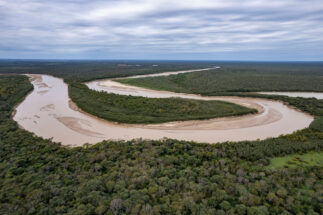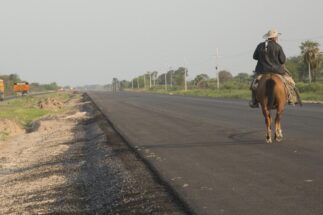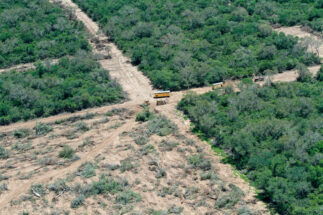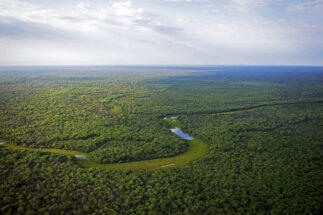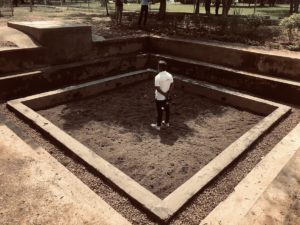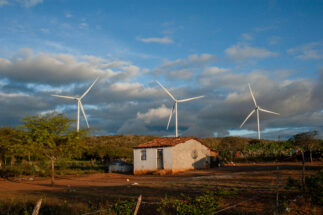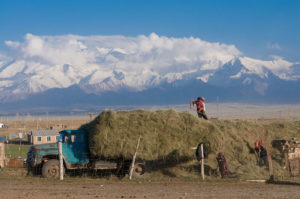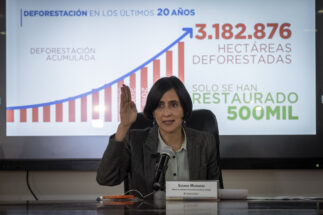Though it attracts less attention than its Amazon neighbour, the Gran Chaco has one of the highest deforestation rates in the world, having lost over a quarter of its forest area since 2000.
Destruction in the biome, which stretches across northern Argentina, Paraguay, southern Bolivia and southernmost Brazil, has been driven in recent decades, in particular, by the expansion of genetically modified soybean production and cattle ranching.
In the province of Chaco in northern Argentina, however, the forest has recently seen a period of uneasy peace. In late 2020, legal protections were introduced to suspend the razing of forests in the province, after its authorities failed to update its land use plan for native forests, known as a “territorial ordering” (OTBN). Argentine law requires provinces to update these orderings every five years, classifying their forest areas by conservation value. Chaco’s most recent ordering, however, had expired in 2014.
More than 376,000 hectares
The area of native forest lost between 2008 and 2020 in the province of Chaco, according to the Agroforestry Network Chaco Argentina.
Despite the court intervention, Greenpeace reports that over 18,000 hectares of forest area were cleared in the province last year, while a further 10,000 hectares have been lost so far in 2022.
The territorial ordering system was established under the Native Forest Law of 2007, which entered into force in 2009. It sets out three categories of classification for forest areas: Category I (Red) for areas of high conservation value that should not be transformed; Category II (Yellow) for areas of medium conservation value, which may be degraded but as long as adequate restoration activities are undertaken; and Category III (Green), areas of low conservation value that can be partially or totally transformed.
According to the deforestation monitoring platform run by the Agroforestry Network Chaco Argentina (Redaf), between 2008 and 2020, the province lost over 376,000 hectares of native forest, mostly in Green but also in Yellow and Red areas, where logging is not permitted.
Despite these losses, in late September, the provincial government presented a proposal to update its land use plan for native forests, under which areas categorised under Green would be expanded, opening the door for yet more deforestation. The proposal still has to be adopted by the provincial legislature, but has nonetheless attracted fierce criticism, with concerns that it will only hasten destruction in South America’s second largest forest.
Indigenous and activists fight deforestation
Epifanio Leiva lives in a small house in the town of Miraflores, the last settlement one passes before taking the dirt road towards the forest known as El Impenetrable.
Leiva’s ancestors lived, and were buried, in a territory of over 10,000 hectares that was later occupied by the provincial government in order to develop this corner of Chaco, mainly being given over to timber production and agribusiness. They were displaced and moved to a smaller plot, where they now make their living by producing indigenous crafts.
“In 1915, my grandfather was told that part of the land between Castelli and Miraflores was going to be divided between the 24 chiefs of the tribe and each of them would receive 10,000 hectares,” Leiva tells us. “More than a century has passed, and we are still waiting for the local authorities to comply with their promise. Now this landscape has lost its natural resources to the hands of criollos, so we cannot continue with our traditional livelihoods with wild animals as we used to.”
Mempo Giardinelli is a celebrated Argentine novelist and Chaco native, who also runs a foundation promoting literacy and education in the province. He explains that Chaco went from being a “jungle” province to a forestry province, and one that developed without planning or environmental awareness.

Driven by the extraction of the hardwood Schinopsis balansae, or red quebracho trees – a name meaning “axe-breaker” – deforestation began apace with the operations of the British logging company La Forestal in the late 1800s.
Although La Forestal disappeared in the 1960s, in the era of the Argentine military dictatorship (1976–1983), the government began to penetrate the deep forest of the Chaco ecoregion.
Today, in the Red conservation areas located in the northwest of the province, only 20-25% of the original forest remains. “I fear that an economy that is forced to make adjustments to comply with an IMF loan will have to sell the natural resources of El Impenetrable to pay its foreign debt,” says Giardinelli, referencing economic pressures linked to Argentina’s debt restructuring with the International Monetary Fund.
Ruben Luca is the Wichí indigneous leader of MOWITOB, an organisation representing Moqoit, Wichí and Toba indigenous groups that controls the so-called Reserva Grande, a 300,000-hectare territory in northern Chaco. Luca says the organisation supports sustainable use of the forests in Chaco, and understands the need to use the resources.
The problem is that the trees, especially the red quebracho and carob are given away,” Luca said. “There are fewer and fewer carob trees left, the logging companies decide the price – and what they pay is miserable.”

Ricardo Tiddi, from the NGO Somos Monte Chaco, said that according to official data, a million tonnes of wood are extracted each year in Chaco – a figure that likely does not give the full picture, given the large amount of wood that is taken out illegally; the true scale may reach levels as high as two to three million tonnes per year.
“It is cheaper for the agroforestry sector to buy land in forested areas which by law cannot be cleared, and to then lobby for special clearing permits, or to just pay the ridiculous [small] fines,” says Tiddi. “What we are witnessing in Chaco is no longer damage to native forests, but simply extinction.”
Tannin factories in Chaco
At the end of 2020, Chaco celebrated the start of operations at two biomass plants that use waste from the tannin industry, which pitch themselves as a “sustainable” energy source.
According to official statistics seen by Diálogo Chino, in 2021, a total of 423,000 tonnes of logs were produced in Chaco, much of it taken from native forest by the provincial forestry industry. Of this output, 38%, or 163,000 tonnes, was destined for the tannin industry, with the remainder of the wood and by-products used by sawmills, carpentry and furniture manufacturers.

The Indunor tannin plant, in the town of La Escondida, processes over 160,000 tonnes of logs per year. Along with Indunor’s other facility in La Verde, also in Chaco province, the plant contributes to the company’s annual production of 25,000 tonnes of tannin, to be used in leather production, oil and mineral processing, cement and asphalt, ceramics and sanitary products.
Michelle Battaglia, Indunor’s president, said that over the last 10 years the company has used wood from deforested land as it was “nonsense to let it burn”. Recent years have seen repeated waves of wildfires blaze across the Gran Chaco, with all four nations seeing some of the worst fires in decades.
For zootechnical engineer Mauricio Tinari, from the Fundación Gran Chaco, species of forestry interest – carob trees and quebrachos, primarily – should be harvested in an orderly manner and by applying the appropriate technical criteria. “If harvesting continues indiscriminately, these trees would be all gone in about 15-20 years,” he says.

Activists from Somos Monte Chaco have long denounced the tannin plants’ use of wood derived from clearing or through changes in land use, many of them without official permits. The organisation’s Tiddi also complains of some of the intricacies, and leniencies, of the punishments.
“When tannin plants are discovered [to have used wood from illegal clearing] and sanctioned by the authorities, the companies or owners of the fields from which the illegal clearing came are sanctioned with fines that can be paid in instalments, and that can be discounted if made as cash payments,” said Tiddi.
Chaco’s development in global context
The proposed new land use plan for native forests has been presented by the provincial government as being “sustainable”, despite its opening up to logging in areas where it is currently prohibited. Chaco governor Jorge Capitanich said that the plan allows for the agricultural sector to expand in a sustainable way, and vowed to improve surveillance systems and tackle illegal deforestation with stronger fines.
Capitanich also said he will raise funds for forest protection and monitoring through the issuance of green bonds, with a system of “Eco-Tokens” that would cover 100,000 hectares of the province’s forests.

The governor recently remarked that “as a country, we must strengthen our environmental creditor strategy”, referring to the fact that Argentina is providing ecosystem services to the rest of the world because of the carbon dioxide captured by its native forests – an argument also used by Argentina’s national government. Carbon credits, traded on international markets, are the subject of growing enthusiasm in the country.
At the beginning of November, Argentine president Alberto Fernández presented the National Plan for Adaptation and Mitigation to Climate Change ahead of the upcoming COP27 climate summit in Egypt. Hot off the back of Lula da Silva’s election victory in neighbouring Brazil, he told press at the plan’s presentation that “together with Brazil and Latin American countries, we are the lungs of the world.”
But new plans in the Chaco put the country’s stewardship of these lungs in doubt. Matías Mastrangelo, a researcher at the National Council for Science and Technology (CONICET), recently wrote in El Diario that the new territorial ordering of native forests in Chaco in fact violates Argentina’s Native Forests Law, as it degrades the conservation value from Green to Yellow of more than 376,350 hectares of native forests.
In Chaco, the provincial ministry of environment has police powers in almost everything related to the control of natural resources, except in the protection of forests, which is managed by the production ministry. “Here, the tannin companies precede the province and the state, so they still believe that they can rule above the law,” said Paula Soneira, a biologist and Chaco’s former undersecretary of environment and biodiversity.
For Soneira, it is no longer just a matter of conserving what the forest law stipulates, but of preparing the province for the effects of climate change: “This year in El Impenetrable and in Chaco’s capital city, we suffered heat spikes that had not occurred before. It is not possible to produce commodities in the same way as 100 years ago. This decade requires adaptation and reducing the severe impacts of climate change.”

In a recent interview, Chaco congressman Nicolás Slimel said he wants to vote on a new proposal that could represent the social and ecological interests of the province, in accordance with the national forestry laws. The working group of which he is part of wants to expand the productive areas of the province without reducing the conservation areas.
Fernando Miñarro, director of conservation at the Fundación Vida Silvestre, an Argentine NGO, said they are still hopeful the new Chaco land use plan for native forests won’t progress. “Even if the Chaco legislature approves this plan, the national government’s environment ministry won’t be likely to support a plan that ignores forest protection,” he told Diálogo Chino.
For Somos Monte Chaco’s Tiddi, the current process around the land use plan is a further exposition of the colonial violence that has marked the region’s history. This pattern of intrusion, he says, endures to this day, as the government continues to impose itself on indigenous peoples – peoples who have been present in the Chaco long before the national and provincial states were founded. In their most recent petition, the NGO made its demands clear: “No more clearing with bulldozers, no more forests can be lost.”
